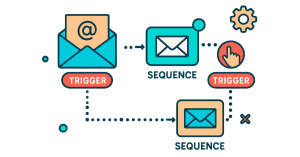Marketing automation technology has already taken powerful marketing channels, like email, SMS (text), social media, and content marketing, into a new age. Thanks to platforms like emfluence, marketers have the ability to send the right message to the right person at the right time and scale with incredible levels of efficiency. And the pace of change isn’t about to slow down anytime soon. The growing influence and continued integration of Artificial Intelligence (AI) into marketing automation platforms means the potential for this technology to quickly evolve into something akin to “marketing magic” is no longer a pipedream.
So, what trends and innovations should we be prepared for in 2025? In this post, we’ve compiled a list of how we believe marketing automation will develop and grow in 2025.
Solving Real-World Problems with Marketing Automation
Successful marketing has always been about solving problems. As marketing organizations and customers become more sophisticated, marketing automation must do more to ensure both parties are catered for and happy.
As businesses increasingly seek greater efficiency in their marketing output and consumers demand more informed engagement, enhanced personalization based on data-driven insights becomes integral to any marketing automation strategy. As such, here are some of the key trends and innovations that are likely to define the marketing automation landscape in 2025:
AI and Machine Learning Integration
Artificial intelligence (AI) and machine learning (ML) will become more deeply embedded in marketing automation tools. These technologies will enable hyper-personalization at scale, offering real-time content recommendations, predictive analytics, and intelligent customer segmentation. This will not only enhance the opportunity to send the right message to the right person at the right time, but also potentially remove irrelevant and potentially damaging ‘noise’ from the marketing conversation, significantly improving the overall customer experience.
Meanwhile, AI-powered chatbots will provide more advanced customer support and sales interactions, understanding context, tone, and customer intent with greater accuracy and assisting prospects and customers to move through the sales funnel with minimum human engagement.
Hyper-Personalization and Predictive Analytics
In 2025, marketing automation technology will move beyond simple demographic data to incorporate more advanced behavioral insights, preferences, and even sentiment analysis.
By employing predictive analytics, marketers will be able to better forecast specific customer behaviors, such as when they’re likely to make a purchase, what products they’re likely to be interested in, and the best time to send offers. We’ve already said it multiple times in this article – right message, right person, right time. This technology will enable marketers to, just like magic, send more targeted campaigns that anticipate customer needs before they arise.
Omnichannel Integration
Marketing automation platforms will continue to expand brands’ opportunities to create seamless experiences across all touchpoints, from email and social media to mobile apps, websites, and in-store interactions. In 2025, we can expect a more connected view of the customer journey, making it easier for marketers to create integrated campaigns that work across multiple platforms simultaneously. This takes the right message, right person, right time mantra and adds the right device to the conversation. Beautiful!
Automated Customer Retention
You win some, you lose some – but wouldn’t it be amazing if your marketing automation platform could predict the customers you were about to lose and take measures to avoid the loss? The good news is that while much of marketing automation has focused on customer acquisition, retention will become a bigger priority by 2025. Marketing automation tools will automatically identify churn risks and create personalized retention campaigns to engage existing customers. These campaigns could include loyalty programmes, special offers, and exclusive content, all designed to keep customers engaged and prevent them from leaving.
Automation will also be used to drive ongoing engagement with customers through reactivation campaigns or upselling opportunities.
Voice and Conversational Marketing
We’ve been talking to our devices for some time now. Thanks to voice-enabled digital assistants like Alexa, Google Assistant, and Siri, voice search and conversational marketing will become even more ingrained in marketing automation technologies. These automated systems will be able to handle more complex voice interactions, enabling brands to deliver highly relevant responses and recommendations based on voice queries.
Conversational marketing will also expand beyond customer service, supporting everything from lead generation to product discovery. We’ve always said that people buy from people they like and trust and that trust is often built on the back of a conversation. Today, that conversation is increasingly likely to be with an AI-enabled assistant.
Data Privacy and Ethical Marketing
There’s no getting away from this stuff. Stricter global data protection regulations (like GDPR or HIPAA) will continue to push companies to be more transparent with data collection and usage. Marketing automation tools will have to incorporate features that allow businesses to manage consent preferences and data usage, ensuring compliance with those regulations while maintaining customer trust. The technology will also need to support compliance with accessibility rules, meaning more consumers will be able to access and engage with your content. This isn’t just a nice thing to do. With millions of US consumers living with issues relating to accessibility, it makes sound commercial sense.
Social Media Automation and Influencer Marketing
The role of social media in marketing will continue to grow, and marketing automation tools will become more advanced in helping brands manage social media interactions, from posting content to delivering customer service.
As marketers move away from celebrity endorsements and focus on building relationships with more targeted industry influencers, AI-enable tools will increasingly be used to identify profitable influencer partnerships by analyzing engagement rates, audience overlap, and brand alignment. These automated tools will also help track influencer campaigns, ensuring better ROI and more authentic partnerships.
Join the Conversation and Solve More Marketing Automation Problems
While these innovations and trends in marketing automation are set to evolve rapidly, it’s crucial to recognize that they don’t occur in isolation. At emfluence, our innovations are driven by a deep understanding of the everyday marketing challenges our customers face. We focus on creating solutions that not only keep pace with industry developments but also address the specific needs and obstacles our clients encounter on a daily basis.
Do you have a marketing problem we can work on together? Contact the marketing automation experts at emfluence today to start a conversation about driving innovation in your organization by emailing expert@emfluence.com.


